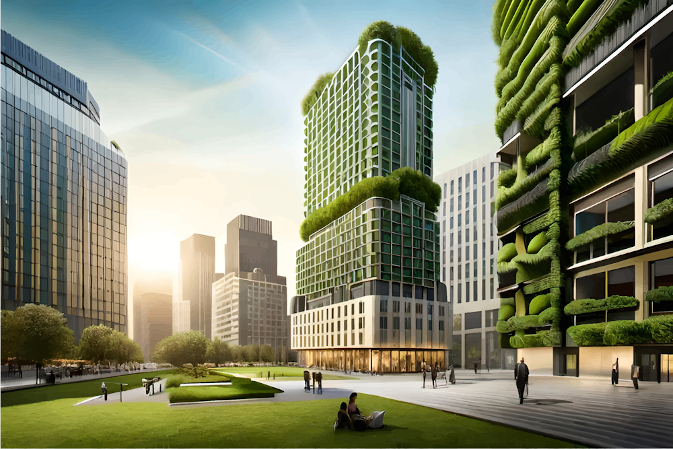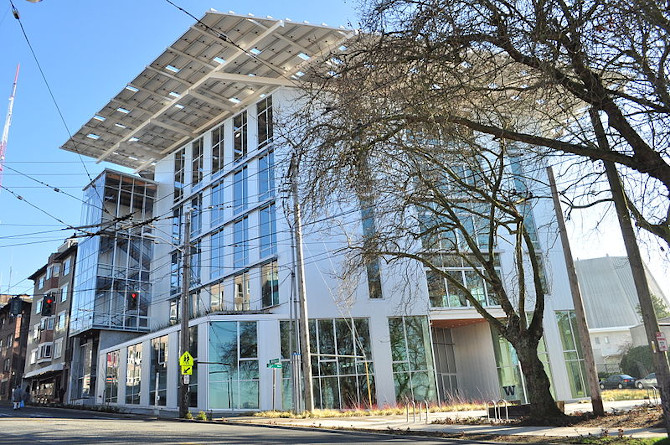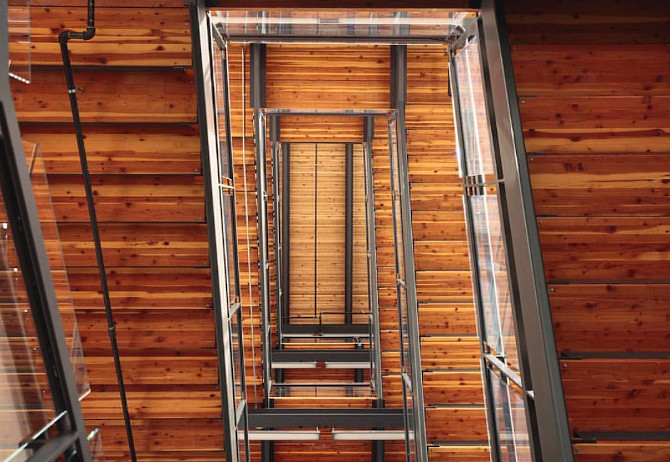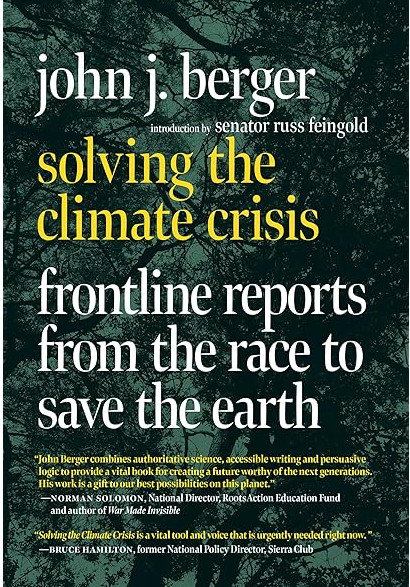Welcome to the World’s Greenest Building

The cantilevered solar roof of the Bullitt Center, which has been billed as the world’s greenest building, is like the flight deck of an aircraft carrier or a giant mortarboard. Some call it a baseball diamond in the sky. Although metropolitan Seattle is the cloudiest major city in the United States, this award-winning six-story commercial office building manages to produce all its own energy via solar power and to supply its own water through rainwater harvesting. In addition, it treats all its own kitchen and bathroom waste, uses no toxic materials, requires little artificial day lighting, and is built to last two-and-a-half centuries. Geothermal heat from the ground beneath the building radiates through the concrete floors to warm the interior. These exceptional features are seamlessly blended into an affordable, ultramodern, energy-efficient structure that is as inviting and beautiful as it is revolutionary. Its very existence is a powerful affirmation of clean energy’s potential for urban transformation.

Using High Tech to Go Low Tech
Unlike conventional buildings, the Bullitt Center responds actively to its environment. As with the nerves of an organism, sensors detect and transmit the temperature, wind speed, sunlight, and precipitation outside the building’s skin into its computerized brain. Then, custom software factors in the building’s interior conditions and sends appropriate control impulses to adjust its heating, cooling, and water systems. Yet this super-high-tech, high-performance building actually uses only 17 percent as much energy as a comparable commercial office building. Over its lifetime, it will generate more than $13 million in carbon-reduction benefits. The building gets energy from the sun, water from the sky, heat from the ground, and daylight and ventilation through its windows. It thus models how people can prosper in harmony with nature. The building designers, in effect, used high tech to go low tech.
To find out how the Bullitt Center came to be, I spoke with the man most responsible for it: Denis Hayes, president of the nonprofit Bullitt Foundation. For a half-century, he’s been one of the nation’s leading environmental thinkers—and doers. With an MBA and a law degree from Stanford already under his belt, Hayes saw his career really take off when former Wisconsin governor and senator Gaylord Nelson selected him as national coordinator for Earth Day 1970. Hayes made the event a worldwide success that helped put the modern environmental movement on the map. A post as head of the Illinois state energy office followed, and soon after, he was named director of the Solar Energy Research Institute (now the National Renewable Energy Laboratory). In 1992, he became president of the Seattle-based Bullitt Foundation, whose mission is to protect the environment and help build sustainable communities in the Pacific Northwest. The Bullitt Center headquarters building might be his crowning achievement.

The Birth of a Living Building
The inspiration for Hayes’s extraordinary career and the Bullitt Center originated in a 1964 epiphany in the desolate Etosha Pan region of northern Namibia, a vast and usually dry lakebed that, after heavy rains, is sometimes flooded by the ephemeral Ekuma and Oshigambo Rivers. Ten-thousand miles away from Etosha Pan, Hayes grew up in a working-class family in the tiny town of Camas, Washington, on the Columbia River.
It was the rainy season in Namibia, and the rivers had flooded into Etosha Pan. The scene was like being in the midst of a National Geographic special, yet it was far from idyllic. “It was very hot during the day. It was freezing at night. I was starving. I’d been alone for a very long time,” Hayes said. The previous evening, he had just had a scarring emotional experience when he stumbled across the first German concentration death camp ever, in the coastal town of Lüderitz, a site marked by an obscure little plaque. “It’s not much known, but they did there at a smaller scale what they later did at Auschwitz,” he said. More than two thousand people of the Herero and Nama tribes who had fought back against German colonization of their land died in the camp due to overwork, disease, starvation, exposure to the elements, and medical experimentation.
After seeing the camp, Hayes spent the following day crossing the desert and then paused in the evening to look back toward the coast. “Suddenly, the combination of my desire for some kind of a unifying explanation of how things operate on earth and should operate on earth, and how we could redesign societies . . . led me to believe that there was something to be learned from nature and from the way that it had sustained itself so well for so long.” He realized then that some principles of ecology—for example, predator-prey relationships—operated in ways that would be destructive in human society. He was looking for natural principles that could make good templates for humanity.
Hayes decided that he would return home and focus the rest of his life on trying to find ways to apply the principles of natural ecology to the human prospect—to figure out how we could prosper in harmony with nature, instead of imposing our will on it. Back in the States, he returned to school, eventually turning his talents to environmental causes and the advancement of solar energy.

Design With Nature
Now in his 70s, walking slowly and unpretentious in jeans and a gray sweatshirt, Hayes captains the Bullitt Foundation from an airy office atop the Bullitt Center. The building “exceeded my hopes, not just my expectations,” he confided to me. Back in 2007, the foundation needed a new home, and Hayes had seen this as an opportunity to create a commercial building that would reflect the foundation’s commitment to clean energy and climate protection. He wanted nothing less than to demonstrate the best sustainable energy performance possible in an urban environment in a way that was affordable and replicable, a model to inspire the creation of sustainable and resilient cities.
The standards for certification that the Bullitt Center had to meet were developed by the International Living Future Institute’s Net Zero Energy Buildings program. According to program director Brad Liljequist, the average net-zero building uses only 60 to 65 percent as much energy as a conventional building. A fully certified Living Building, however, has to do more. For full Living Building certification, a building must pass an independent audit to confirm that, on an annual basis, it uses net-zero energy, consumes net-zero water, and meets the world’s highest energy efficiency and green building standards—that is, 20 stringent “imperatives,” each with its own formal criteria, for performance areas that include water use, energy, health, materials, equity, and beauty. Achieving the health standard, for example, means the structure must be toxin-free and supportive of its occupants’ health; hundreds of common construction materials must be avoided just to clear this bar. All energy used must be produced on-site, without combustion, which means it must come from renewable energy sources. Buildings thus must simultaneously meet high aesthetic, efficiency, equity, construction, and durability standards. The standards range beyond the nuts and bolts of the building to include imperatives like “biophilia,” or the nurturing of a sense of connection with nature.
Of 400 buildings currently registered for the “Living Building Challenge,” 75 have met some of the standards, but only a few have achieved them all. “The Bullitt Center is a world champ in its class,” says Liljequist—one of only 10 fully certified living buildings on the planet.

Slashing Building Energy Use
How much energy could be saved across the nation if net-zero-energy buildings were the norm rather than the exception? “About 40 percent of the energy [in the United States] is currently being used in buildings,” Brad Liljequist reminded me. “So, we’re talking about taking that down toward zero percent.”
Of course, no one’s going to wave a magic wand and suddenly transform the entire building stock of the United States to operate on net-zero energy. But if zero-energy buildings became the norm in new construction through economies of scale, they likely wouldn’t be any more expensive than current buildings, except for the installation of on-site solar power or other clean-energy generation systems. Zero-energy buildings are already starting to catch on: In 2021, the United States and Canada had 700 net-zero-energy commercial building projects and thousands of net-zero-energy and energy-positive single- and multi-family home projects. Now that net-zero-energy and ultra-low-energy buildings are feasible virtually everywhere, federal, state, and local governments could establish ambitious annual goals for retrofitting existing buildings and requiring all new buildings to employ cost-effective efficiency measures and use 100 percent renewable energy. Whereas it isn’t generally possible or cost-effective for high-rise office buildings to generate all their own power on-site, they could acquire 100 percent of their energy from off-site clean-energy power plants.
The United States has about 6 million commercial and industrial buildings and 105 million residential buildings. Could the nation set an ambitious deadline for ensuring that they all meet high energy efficiency standards? The U.S. Environmental Protection Agency’s voluntary energy efficiency program, Energy Star, established in 1992, has to date certified only thirty-thousand or so commercial and industrial buildings as Energy Star compliant. At that rate, it will take almost six thousand years to get all of those buildings certified.

A Trillion Saved, a Trillion Earned
Roughly $4 trillion is spent every decade to provide energy in U.S. commercial and industrial facilities where a third or more of that energy ($1.3 trillion worth) is wasted. So, not to have an effective national program in place to certify all U.S. buildings for energy efficiency is a notable policy failure.
I discussed this problem with Steven Nadel, current director of the American Council for an Energy-Efficient Economy (ACEEE). Not many people can say that their organization was instrumental in saving the U.S. public a trillion dollars, but the ACEEE did so through the impacts of the national appliance efficiency standards it helped establish. Nadel would like to see states and localities adopt the French system of promoting energy conservation with building energy ratings. “In France, they have these A-to-G labels,” and a ban on selling or renting G- rated buildings took effect in 2020, to be followed by others: “You can’t sell or rent an F [-rated building] after 2025,” Nadel said. “People had many years to prepare. . . . I use that as an example of what may be needed to help generate impetus for the [energy] savings we need and the jobs.” To retrofit all existing U.S. commercial and industrial buildings by 2045, about 5 percent of them would need to be fixed annually, starting in 2025. That would mean retrofitting nearly 300,000 buildings a year.
Absent the widespread use of a mandatory building energy rating system to drive retrofitting, federal loan guarantees and tax incentives could be mustered. Retrofits are labor-intensive, Nadel reminded me, and that means an ambitious national building energy efficiency program could be a big source of new, well-paying domestic jobs that could not be offshored. Although states and cities can provide building codes, their ability to provide financing is limited. The federal government, however, could provide leadership and ample, predictable financing for a major national building retrofitting campaign to address the climate crisis. According to ACEEE, not only do such efficiency investments repay themselves more than three times over, dollar for dollar, but they also boost GDP, create new jobs and, as an added bonus, often make buildings more comfortable and healthier for occupants while saving those occupants money on utility bills. Meanwhile, the reduction in energy use curtails pollution, improves public health, and protects the climate. Energy efficiency even improves social equity in a nation with vast disparities in income and wealth: greater efficiency means that low-income households that spend disproportionately on energy are relieved of some burdensome costs.
Adapted from Solving the Climate Crisis: Frontline Reports from the Race to Save the Earth. Published with permission.
Author Bio:
John J. Berger is an environmental science and policy specialist, prize-winning author, and journalist. His latest book is Solving the Climate Crisis: Frontlines Reports from the Race to Save the Earth (Seven Stories Press, 2023).
Photo Credits: Depositphotos.com; Joe Mabel (Wikimedia, Creative Commons); Pxhere (Creative Commons); Peter Alfred Hess (Flickr, Creative Commons).































































































































































































































































































































